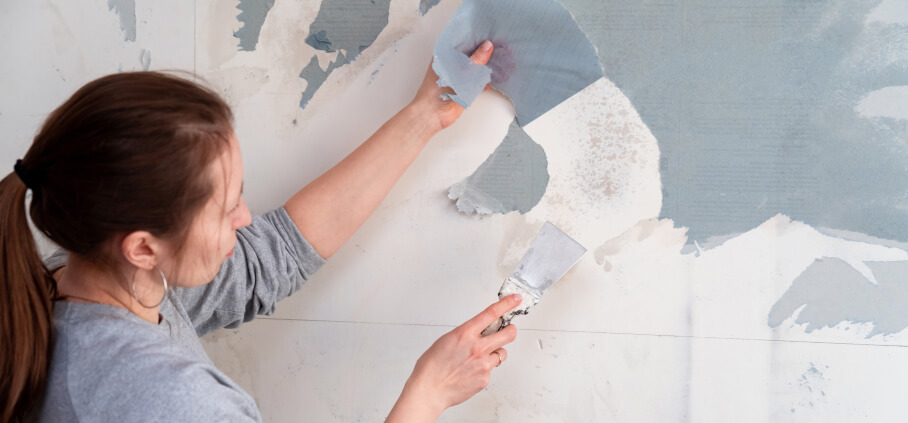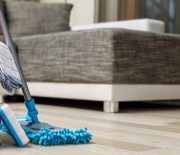Last update: 2 years ago

Wallpaper is an affordable interior decoration that comes in many different colours and patterns. That is why many homeowners in Australia choose it to bring life and personality to their space that cannot be easily achieved with paint.
However, when the time comes to remove the wallpaper, people see how hard and time-consuming this task can be. Wallpaper glue is strong and when a wall is stipped from the wallpaper, it leaves behind a sticky residue.
If you, too, are wondering how to remove the wallpaper glue from the walls and overcome this otherwise weary job, you have come to the right place. In this post, you will find easy techniques and the necessary materials, all of which can be found in your home or the local hardware store.
Is it really necessary to clean the walls after removing wallpaper?
Although you might feel tempted to skip the glue removal and move right to the next step, it is important to understand that applying paint over wallpaper glue or placing new wallpaper to cover it up is not advisable.
The majority of wallpaper glues, also known as wallpaper paste or wallcovering adhesive, are water-based, similarly to most wall paints. That is why, when you put paint over glue, mixing their components, the glue will be reactivated. The result will be a chunky, uneven wall. Moreover, there is the chance that the paint won’t be able to stick fully to the surface below and it will chip off in time.
This also applies to placing new wallpaper over old glue. If there is a huge amount of glue left on the wall, once you install a new wallpaper, the wall might look uneven or the wallpaper might even peel off shortly after because it hadn’t stuck tightly to the surface. Not the result you would hope for, right?
But don’t let that discourage you! Removing wallpaper glue can be fairly simple if you know what to do and you have the necessary tools.
How to remove wallpaper glue for good
Our bond cleaners have seen a lot, and over time they have amassed a number of useful techniques when it comes to getting rid of wallpaper glue. However, before you go into the essence of the task, you will need to prepare your space for work.
Move any furniture that might get in your way or cover them with drop cloths. Remove any appliances, accessories and rugs. Lay a protective layer over the floor to keep any dirt away. You can use drop cloths here as well. Prepare some garbage bags for the removed residue. And, of course, make sure you have all the right tools and materials before starting to remove the wallpaper glue.
Tools and materials:
- Ladder
- Gloves
- Bucket
- Hot water
- Mild colour-free liquid soap
- Baking soda
- White vinegar
- Sponges
- Putty knife
- Clean microfibre cloths
- Utility knife
- Fabric softener
- Spray bottle
- Sandpaper
- Sanding block
- Drywalls can be damaged by liquid solutions because they have a paper surface. It is OK to only moisten drywall while trying to remove the wallpaper glue, but make sure to never leave the surface wet for more than 15 minutes.
- Work carefully with the putty knife. Scrapping too aggressively can hollow out softer areas of the drywall.
- It is okay to use water extensively on plaster when trying to remove the glue from the wallpaper.
- Always work in small sections. You don’t want an area to dry out before you have had the chance to scrape the glue away.
Remove wallpaper glue with vinegar, baking soda and soap
Perhaps the most popular cleaning technique is the one that uses home remedies such as vinegar, baking soda and soap. It is very easy to get your hands on those products, but what’s more important, they are also very effective. Here is how you can easily approach the task.
Step-by-step glue removal process:
- Mix hot water with dish soap in a bucket, then add a tablespoon of baking soda and one cup of vinegar for every 3-4L of water used.
- Soak the sponge into the solution, squeeze out the excess liquid and carefully tap over the glue residue.
- Wipe a small section of the glue with a rag.
- Use a putty knife to scrape away every last bit of the residue.
- Wipe the left solution off the wall with circular motions, using a clean cloth.
- Leave the windows open to fully dry the wall and eliminate the risk of mould forming later on.
Remove adhesive from a wall with fabric softener
If a wallpaper has stayed on the wall for a very long time, there is a chance that the glue will be very stubborn and difficult to remove. Fortunately, nowadays there is an innovative solution that does miracles with wallpaper glue and can be easily found in almost every store.
Surprisingly as it may sound, the miraculous product is the fabric softener. That’s right! This same product that makes your clothes smell pleasant, can also solve your wallpaper problems. This is because of the fabric softener’s ability to break down the glue. Now, let’s dip into it!
Step-by-step wall adhesive removal process:
- Carefully make crisscrossed cuts into the wallpaper residue with a utility knife. Don’t press too hard, the cuts shouldn’t be deep.
- Wash the walls with hot water, then wait a few minutes for the water to work its way. If you notice any wallpaper residue peeling away, pull off as much of it as you can.
- Mix equal amounts of warm water and softener and pour it into a spray bottle for easier application.
- Saturate the wall by spraying the solution and wait 15 minutes for the softener to reach the glue through the cuts you have made.
- Gently scrape the adhesive away with a putty knife.
- Wait 24-48 hours for the wall to fully dry.
Sand wallpaper glue off
Sanding off is another effective method for dealing with stubborn and challenging adhesive on walls. If the other methods don’t work, use medium-grid or fine-grit sandpaper to get rid of the thick and sticky wallpaper residue and enjoy a smooth, ready for a new decoration surface. Here is how to do it:
Step-by-step wallpaper glue sanding off process:
- Place the sandpaper over a sanding block
- Use back and forth motion to sand adhesive away from the surface.
- Replace the sandpaper when it wears off.
- Remove any remaining residue (if any) with warm soapy water and let the wall dry.
How to tell if the wallpaper glue is removed?
The easiest way to tell if you have fully gotten rid of any adhesive residue is by moisturising the wall and running your finger over it. If the surface feels slimy or sticky, then it certainly has wallpaper glue remaining.
Another way is by holding a flashlight parallel to the wet surface. Wallpaper paste has a slight dark sheen so check if you can see any visibly darker patches. If that is the case, you will need to repeat the cleaning process all over again.
However, you can also use a gel stripper to get rid of the remaining sticky residues. Spray the affected areas and let them sit for 15-20 minutes. Then scrape off the gel along with the remaining glue and rinse with water. Finally, you can step back and enjoy the delightful results of your hard work.
If you still don’t feel certain the wallpaper glue is completely lifted from the wall, you can have a professional cleaner take a look. Or why now skip all the hassle and leave the wall cleaning task to a seasoned pro?
Removing wallpaper glue seems like too much work?
Contact a Fantastic cleaner for a smoothly done job!
Takeaways
- Removing wallpaper is a tough task because it leaves glue residue that is difficult to clean.
- If wallpaper glue is not removed fully it can cause new paint or wallpaper to look uneven or peel off.
- There are three main techniques for cleaning wallpaper adhesive: using a solution of baking soda, soap and vinegar, applying fabric softener or sanding the glue off.
- Wetting the wall can help tell if the surface is fully free from the adhesive.
- Calling a professional cleaner ensures the job is done to perfection and gives you a chance to watch and learn.








